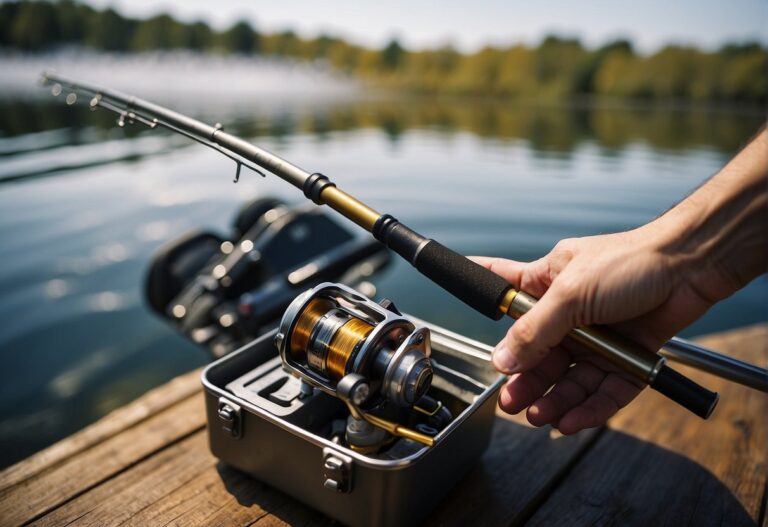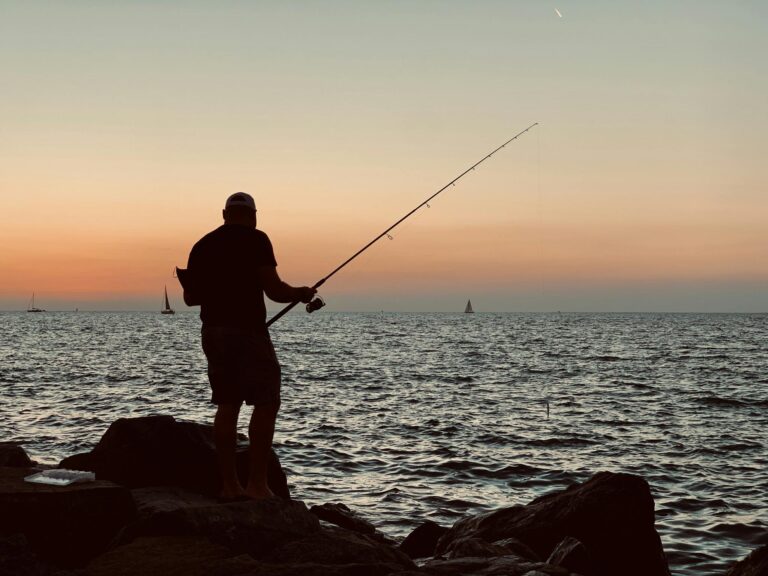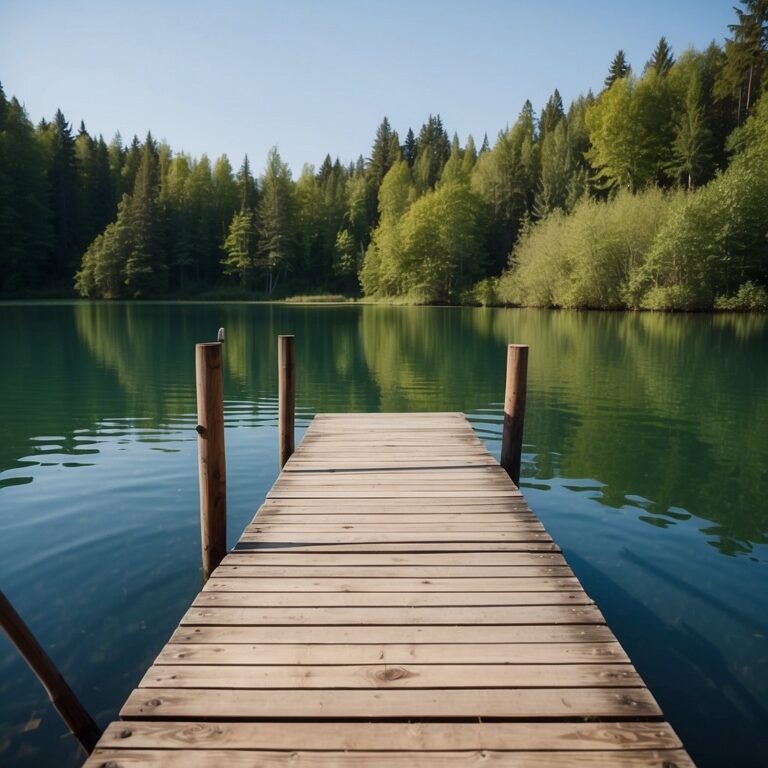What Is the Best Barometric Pressure for Fishing? Unlock the Secrets to a Great Catch!
As an avid angler, you might often find yourself pondering over the whims of the fish below. The secret to unlocking their patterns may literally be in the air. Barometric pressure measures the weight of air pressing down on the earth and its waters. It can be the crystal ball that foretells your success on the water.

For the best fishing experience, you’ll want to keep your eye on that barometer. When the pressure is just right, between 29.70 and 30.40 inches of mercury (inHg), give or take, you’re likely to find the fish in a rather cooperative mood. This is the sweet spot where you can toss out your new lures or put your latest techniques to the test. Fish don’t carry umbrellas, but they sure know when a storm is brewing, and they change their behavior accordingly, just as we might when dark clouds loom overhead.
Remember, it’s not just about casting the line; it’s about casting it at the right time. When barometric pressure hits the highs and lows, fish adopt new scripts. High pressure often brings about clear skies and potentially slower bites. Meanwhile, low pressure hints at rainy skies and more sluggish finned friends.
Understanding Barometric Pressure
When you plan for a fishing trip, understanding how barometric pressure affects fish behavior is like knowing the secret handshake to an exclusive club; it unlocks potentials and possibilities.
Basics of Atmospheric Pressure
Atmospheric pressure, simply put, is the weight of the air above us. Imagine an invisible sea where you’re at the very bottom, with the waves of air pressing down. You’re constantly under the pressure of this airy ocean, but since you’re a terrestrial creature, you might not notice it the way fish do.
- Standard Atmospheric Pressure at sea level: 29.92 inches of mercury (inHg)
- Sea creatures react to even slight changes in this invisible ‘sea’.
Measuring Pressure: Inches of Mercury and Millibars
To get a measure of atmospheric pressure,
- Grab a barometer and take note of the reading:
- It could show pressure in inches of mercury (inHg), which is like the ruler that measures the depth of our airy sea.
- Or it could measure in millibars (mb), where 1013.25 mb is the standard atmospheric pressure at sea level, akin to the full tank measurement for your fish-finding mission.
- Conversion to note: 1 inHg = 33.8639 mb, or vice versa, because sometimes sea creatures and weather speak different languages.
Barometers and Weather Stations
Barometers are your personal forecasters and advisors all condensed into one tool. They’re the wise old sages of the fishing gear world, hinting at whether you’ll have a calm day at the lake or be greeting a flurry of activity.
Types of Barometers:
- Mercury barometer: The traditional, column-of-silver type that can look quite grand on your wall.
- Aneroid barometer: No liquid insight, these often come with dials and numbers, like a clock showing fish o’clock!
-
Weather Stations: Think of these as the high-tech cousins of barometers. They’re the all-in-one gadgets that not only measure pressure but also throw in temperature, humidity, wind speed, and sometimes more data than you can shake a fishing rod at.
Incorporating this knowledge with a touch of humor will make sure that you’re both entertained and informed, ready for your next fishing adventure.
Barometric Pressure and Fish Behavior
Understanding how barometric pressure influences fish behavior is essential for a successful fishing day. It’s not just folklore; it’s about biology and physics shadow dancing under the water’s surface.

Pressure Impact on Swim Bladder
- The swim bladder in fish functions like a buoyancy control device, and variations in barometric pressure can make it expand or contract.
- When the pressure drops, the swim bladder expands, making fish feel fuller and less likely to feed aggressively. They might just nibble on your bait as if they’re on a diet.
Feeding Habits and Barometric Pressure
- Stable Pressure (29.70 – 30.40): Fish go about their day with normal feeding behaviors.
- High Pressure (30.50+): Fish may act like they’ve just watched their favorite thriller — they’re more cautious and prefer staying closer to their hideouts.
- Low Pressure (29.60 and lower): It’s like fish have a forecast and know a storm is coming. They often feed more urgently before pressures plummet further.
Bass Fishing and Weather Patterns
- A slight dip in pressure has bass feeling frisky and more active, searching for a feast. They’re like teenagers at a buffet — they want food, and they want it now.
- As barometric pressure rises, bass might play hard to get. Your lure needs to be irresistible because they’re playing the role of the uninterested date, not biting easily.
Trout Response to Pressure Changes
- Trout react to pressure changes as if deciding whether to leave a comfy bed. Lower pressures might encourage them to “stay in” and be more lethargic.
- Conversely, when things stabilize, they’re more likely to “go out” and actively feed. They like their weather like they like their streams: predictable and stable.
Optimal Barometric Pressure for Fishing

Barometric pressure can be the invisible puppeteer of your fishing experience, pulling the strings on fish behavior. Knowing the right conditions can help you become the maestro of the fishing rod.
High-Pressure Conditions
Under high-pressure systems, skies often blush with calm, clear serenity. Fish might play hard to get, as they tend to be less active:
- Catchability: Challenging, fish play coy
- Strategies:
- Deep water techniques might be more successful
- Slow down your bait presentation
Low-Pressure Conditions
When the barometer dips like a tipsy sailor, signaling an incoming storm, fish sense the drop and their feeding activity might ramp up:
- Catchability: Improved, fish throw caution to the wind
- Strategies:
- Use this time to experiment with faster, more aggressive luring
- Target areas where fish may seek refuge before the storm
Fishing During Stable Pressure
Stable pressure is like a reliable old friend; it won’t surprise you much. Fish behavior isn’t as erratic, making this a comfortable zone for trying out your shiny new lures.
- Catchability: Steady, as reliable as an old favorite lure
- Bait Tips:
- Mixed bait tactics can be effective
- Maintain a consistent retrieval speed
The Ideal Barometric Pressure for Fishing
Constraint the barometer and you’ll find the sweet spot for fishing pressure is usually between 29.70 and 30.40 inHg. This range is the Goldilocks zone, where fish are not too lazy nor too skittish – just right for your hook:
- Golden Range: 29.80 to 30.20 inches of mercury
- Why It’s Ideal:
- Fish are active and responsive
- Balanced conditions offer variety in fishing methods
Weather Influences on Fishing Success

When you’re planning your fishing trip, paying close attention to the barometric pressure and weather changes can be just as crucial as choosing the right lure. With weather being as fickle as fish themselves, understanding its impact on your quarry’s behavior could mean the difference between a story about the one that got away and a photo of the one that didn’t.
Predicting Weather Changes
To predict weather changes, keep an eye on the barometric pressure readings through a reliable weather app or a trusty barometer:
- Stable Pressure: When pressure holds steady, fish patterns are predictable; it’s business as usual underwater.
- Falling Pressure: Before a storm, pressure drops and fish may go on a feeding frenzy, so it’s a good time to cast your line.
- Rising Pressure: After a storm, pressure rises and fish tend to become less active, making them harder to tempt.
Impacts of Weather Fronts
Different fronts have distinct effects on fish behavior, so it’s vital to sync your fishing expeditions with Mother Nature’s mood swings:
- Cold Fronts: These can cool down the fish’s biting enthusiasm as much as it does the air temperature. Fish may go deeper and be more sluggish.
- Warm Fronts: If you want a bit of fishing drama, a warm front heats up the action, encouraging fish to be more active and likely to bite.
Adjusting Techniques to Weather
Your fishing techniques should shift like the wind when the weather plays its hand:
- In stable weather conditions, maintain a consistent approach with techniques that have worked for you in the past.
- With falling pressure and an approaching storm, ramp up your efforts and take advantage of the fish feeding actively; use more aggressive techniques.
- During rising pressure, after a front has passed, you might have to switch to more subtle techniques or finesse lures to tempt the less active fish.
Effective Fishing Techniques
When barometric pressure shifts, it’s like the fish send you a text message saying, “Let’s change things up!” Stay ahead of the game by tailoring your approach.
Adapting to Rising Barometric Pressure
As the pressure climbs, fish put on their snug blankets and settle in. They become less active, but you can still coax them out to play.
- Slow Down Your Retrieval: Use a slower retrieve to entice these cozy fish, like convincing a cat to leave a warm lap.
- Fish Deeper Waters: They might retreat to the depths, so drop your line where the water gets chillier.
Strategies for Falling Pressure
When pressure falls, fish go on a shopping spree, darting around with energy. This is your chance to take advantage of their “sale mode.”
- Increase Your Retrieval Speed: Pick up the pace to keep up with the active fish, just like a Black Friday rush.
- Try Different Depths: Some fish may rise higher in the water column, so test the waters at various levels.
Lure Selection Based on Pressure
Choosing lures is like picking the right outfit for the weather – you gotta match the mood.
- Topwater Lures: These are your go-to when pressure is stable or rising slightly. It’s like tapping on the fish’s window saying, “Hey, look up here!”
- Subsurface Lures: As pressure starts falling, consider switching to subsurface lures to dive into the action where fish are more likely to feed.
Bait and Lure Tactics
The right bait turns an ordinary fishing trip into a banquet for bass and a feast for your fishing ego.
- Live Bait: On steady or rising pressure days, live bait can be the real MVP, moving just enough to whisper, “Bite me!”
- Synthetic Baits: As the pressure drops, break out those colorful fakes. They’re like the fast food of the sea during the dinner rush.
Practical Tips for Fishing in Various Pressure Conditions
When the pressure’s on, don’t let it get to you. Reel in success with these savvy strategies for every kind of barometric mood swing.
Utilizing Weather Apps and Forecasting Tools
- Get a Forecasting Edge: Arm yourself with a reliable weather app or fishing barometer tool. It’s like having a crystal ball that lets you peek into the atmospheric pressures to come.
- Apps like FishWeather or the Weather Channel can provide you with hourly updates on barometric pressure forecasts.
Finding the Right Cover and Depth
- High Pressure (30.40 inHg and up): Seek shade under docks and vegetation where fish might be lounging like tourists under an umbrella.
- Lower Pressure (Below 29.70 inHg): Fish tend to explore more liberally, so you may need to go into the aquatic version of hide and seek in deeper waters.
Maintaining Safety and Comfort
- Dress Appropriately: You wouldn’t go to a snowball fight in shorts, so don’t be unprepared for the weather’s whims.
- Stay Alert: Good ol’ Mother Nature can switch moods faster than a cat being told it’s bath time. Keep an eye on your fishing barometer to stay ahead of the game.
Species-Specific Considerations
When it comes to fishing, it’s not just about the barometric pressure; it’s about understanding the peculiar habits of your scaly targets and how they tend to react to the whims of the weather.
Targeting Specific Fish Types
Each fish species has its own barometer of comfort when it comes to pressure changes. Consider:
- Bass: They tend to feed more before a pressure drop, so keep an eye out as the barometer falls.
- Trout: These finicky swimmers prefer stable, high pressure, so if the barometer reads like a steady mountain peak, it’s time to cast your line.
- Walleye: Masters of the deep, they slyly respond to a slow fall in pressure by becoming more active—your cue to strike.
Adaptations to Local Weather Patterns
You become a fish whisperer by tuning into the local weather song that fish dance to:
- The Southern Sway: In warmer climates, fish might enjoy a leisurely afternoon escape even under a strong sun-lit high pressure.
- The Northern Waltz: Colder regions see fish donning their full winter coats, cozying up in the deeper alcoves when low pressure systems loom.
Physiological Adaptations of Fish
Fish are the original barometers with fins. Their swim bladders, internal air-filled organs, react to pressure changes:
- When pressure plunges, beware: fish might feel as bloated as you do after a big meal, making them lethargic and less likely to bite.
- A gentle rise in the barometer, however, can make fish feel like they’re on cloud nine, often leading to a feast — so ready your lure for the taking.
Frequently Asked Questions
Let’s tackle some common curiosities you might have when it comes to barometric pressure and fishing.
How does barometric pressure affect fishing conditions?
Barometric pressure, which is the weight of the atmosphere, can play a bit of a puppet master with fish behavior. When the pressure is high, fish tend to be more sluggish and tuck themselves away. A dropping pressure usually indicates a brewing storm, setting the stage for more active fish movement as they feed in anticipation of the weather change.
Can barometric pressure influence the behavior of different fish species?
Absolutely! Each fish dance to the rhythm of the pressure changes in their own unique style. For example, some species might find a steep pressure drop as a dinner bell, leading to a burst of feeding frenzy, while others may react oppositely, becoming less active and more difficult to entice.
What are the ideal barometric pressure conditions for saltwater fishing?
- Fish on the move: Watch for a stable or rising pressure between 29.70 and 30.40 inches of mercury (inHg).
- Fair weather friend: A high and steady barometer, typically over 30 inHg, often means clear skies and calm seas, preferred by many saltwater species.
How can I use a barometer to determine the best fishing times?
- Read it and reap: Check your barometer; a steady or slowly rising pressure is your green light.
- Timing is everything: Fish usually feed more at the onset of changes in pressure, so hit the water when you notice a shift starting.
Is there a specific barometric pressure range that increases the chances of catching bass?
You bet! Bass are known to have a good appetite when the barometer reads between 29.5 to 30.5 inHg. Think of this zone as the bass’s comfort food level—they’re more likely to come out for a bite.
How does a change in barometric pressure forecast impact fishing success?
When you see the forecast pointing to a pressure change, it’s time to plan your script:
- Pressure drop: Your cue to act fast. Fish will be gathering their snacks before the storm crashes the party.
- Pressure rise: Relax a tad, as the fish will still be dining, just at a more leisurely, arguably snobbier pace.



